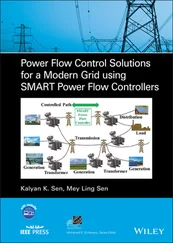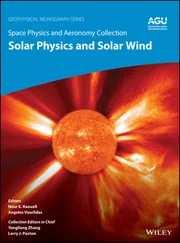Rajiv K. Varma - Smart Solar PV Inverters with Advanced Grid Support Functionalities
Здесь есть возможность читать онлайн «Rajiv K. Varma - Smart Solar PV Inverters with Advanced Grid Support Functionalities» — ознакомительный отрывок электронной книги совершенно бесплатно, а после прочтения отрывка купить полную версию. В некоторых случаях можно слушать аудио, скачать через торрент в формате fb2 и присутствует краткое содержание. Жанр: unrecognised, на английском языке. Описание произведения, (предисловие) а так же отзывы посетителей доступны на портале библиотеки ЛибКат.
- Название:Smart Solar PV Inverters with Advanced Grid Support Functionalities
- Автор:
- Жанр:
- Год:неизвестен
- ISBN:нет данных
- Рейтинг книги:3 / 5. Голосов: 1
-
Избранное:Добавить в избранное
- Отзывы:
-
Ваша оценка:
- 60
- 1
- 2
- 3
- 4
- 5
Smart Solar PV Inverters with Advanced Grid Support Functionalities: краткое содержание, описание и аннотация
Предлагаем к чтению аннотацию, описание, краткое содержание или предисловие (зависит от того, что написал сам автор книги «Smart Solar PV Inverters with Advanced Grid Support Functionalities»). Если вы не нашли необходимую информацию о книге — напишите в комментариях, мы постараемся отыскать её.
Smart Solar PV Inverters with Advanced Grid Support Functionalities
Smart Solar PV Inverters with Advanced Grid Support Functionalities’
Smart Solar PV Inverters with Advanced Grid Support Functionalities — читать онлайн ознакомительный отрывок
Ниже представлен текст книги, разбитый по страницам. Система сохранения места последней прочитанной страницы, позволяет с удобством читать онлайн бесплатно книгу «Smart Solar PV Inverters with Advanced Grid Support Functionalities», без необходимости каждый раз заново искать на чём Вы остановились. Поставьте закладку, и сможете в любой момент перейти на страницу, на которой закончили чтение.
Интервал:
Закладка:
Chapter 9deals with some of the fast‐emerging trends with smart PV inverters. Some application examples are presented of enhanced grid support capabilities enabled by integrating the smart inverter functionalities of solar PV inverters, Battery Energy Storage Systems and Electric Vehicle Chargers. A new technology of “grid forming inverters” that is presently being widely researched across the world, is introduced.
The main focus of this Chapter is to describe the field demonstrations of novel smart PV inverter functions which can provide significant cost savings and benefits to power transmission and distribution systems. These advanced grid support functions are presently not mandated in any Standard worldwide for grid interconnection of solar PV systems. These functionalities include fast frequency response, flexible solar operation, reactive power at night, and night and day PV‐STATCOM technology for providing several FACTS functionalities. This Chapter presents some thoughts on potential financial compensation mechanisms to smart PV inverters for providing grid support functionalities that go beyond being just “good citizens” on the power transmission and distribution systems.
This book is intended for academics, graduate students, utility engineers, system planners, system regulators, system operators, and inverter manufacturers. It starts by providing fundamental understanding of various aspects of smart inverter controls and their functionalities. It then presents advanced controls and novel functionalities of smart inverters for enhancing power system stability and reliability through detailed small signal and electromagnetic transient simulation studies. The book however does not cover protection systems and communications systems for smart inverters.
This book is written both to provide intuitive understanding of smart inverter concepts for beginners as well as advanced knowledge for adepts. The book therefore treads a middle path of presenting mathematical formulations with only a moderate level of complexity. Since the available knowledge on smart inverters is extremely vast the approach in the book is to explain the essential aspects and provide an exhaustive list of references for subsequent reading.
It is hoped that this book will inspire readers into the realm of smart inverters. This is the first book exclusively devoted to smart inverters, to the best of author’s knowledge, and is very likely to have inadvertent errors and omissions. The author sincerely apologizes to all the readers for the same, and requests that these errors may kindly be communicated to him so that they may be rectified later.
Rajiv K. Varma
ACKNOWLEDGMENTS
I consider myself extremely fortunate to have learned and to be inspired by some of the extraordinarily distinguished and selfless teachers, researchers, and individuals, to whom I shall forever be grateful beyond words. Their immense wisdom has tremendously helped shape my career and which has eventually led to this book.
I first express my profound gratitude to Dr. K.R. Padiyar, my teacher and PhD thesis supervisor at IIT Kanpur, who initiated me into power systems and FACTS, and taught me the fundamentals of how to do research and write it. He had so much to teach me, but I could learn only little due to my own limitations. It is indeed a blessing in my life to be his student.
My sincere thanks to Dr. Narain Hingorani, the inventor of FACTS technology, who has been an enormous inspiration in my career.
My heartfelt gratitude to Dr. M.A. Pai, who has continuously supported and encouraged me throughout my academic career and during the process of this book writing. I am immensely grateful to Late Dr. Prabha Kundur, who incessantly inspired and motivated me all along in my career, and especially so, while writing this book. My true gratitude is also due to Late Michael Henderson for his constant encouragement in my research and in this book writing.
John Paserba has played a very important role in my career and for this book, for which I can never thank him enough. I am indebted to him for firstly reviewing the book’s manuscript and providing very meticulous comments which greatly helped in improving the book. He then very kindly agreed to write the Foreword which is indeed an enormous honor for this book.
I also greatly appreciate Dr. Ram Adapa, Dr. Benjamin Jeyasurya, and Oleg Popovsky for reviewing the initial book proposal and graciously recommending that this book be published by Wiley/IEEE Press.
I sincerely thank IEEE, CIGRE, Electric Power Research Institute (EPRI), National Renewable Energy Laboratory (NREL), North American Electric Reliability Corporation (NERC), CEATI International Inc., Western Electricity Coordinating Council (WECC), Lawrence Berkeley National Laboratory (LBNL), California ISO (CAISO), and EU‐PVSEC for providing copyright permissions to reproduce some of their material in this book.
I am immensely grateful to Janice McMichael Dennis, President and CEO, Bluewater Power Group of Companies, and Tim Vanderheide, former Vice President, Bluewater Power, Sarnia, for their constant research support. They were extremely generous to provide their solar farm site for demonstrating my PV‐STATCOM technology for the first time in Canada, and perhaps in the world. I am further very appreciative of Bluewater Power for providing the nighttime picture of their solar farm site for PV‐STATCOM field demonstration, and ABB Asea Brown Boveri Ltd., Switzerland, for the morning picture of their solar farm, which adorn the cover of this book.
I sincerely thank Ben Mehraban, Stephen Williams, and Dr. Hemant Barot for providing valuable insights on the practical aspects of solar PV systems and FACTS, which I have included in this book.
I convey my indebtedness to The University of Western Ontario for having me, and providing all the support and facilities for performing my research in solar PV systems and FACTS. My profound thanks to Dr. Ken McIsaac, Chair of Electrical and Computer Engineering Department, for his support for my PV solar systems research and in writing this book.
I greatly appreciate my former MESc students Sridhar Bala Subramaniam, Mahendra A.C., Byomakesh Das, and Vishwajitsinh Atodaria; former PhD students Shah Arifur Rahman, Ehsan M. Siavashi, Hesamaldin Maleki, Reza Salehi, Mohammad Akbari, and Sibin Mohan; and former Post Doctoral Fellows Dr. Vinod Khadkikar and Dr. Iurie Axente for their research on different aspects of PV‐STATCOM technology. Each one has also helped me in a unique way in this book writing by performing some system studies included in this book, doing literature search, and drawing figures. To each one of them, individually, I express my sincere thanks.
I wish to express my gratitude to the entire team of John Wiley & Sons led by Mary Hatcher for kindly agreeing to publish this book and for providing all the support throughout the publication process. I also wish to sincerely thank Victoria Bradshaw for developing the book cover, Teresa Netzler for supervising the book’s production, and Viniprammia Premkumar for preparing the final version of the book in such an excellent manner for printing.
Finally, I owe this book to my wife Malini and children Sarvesh and Ratna without whose immense sacrifices, immeasurable patience, and limitless support this book would have never happened.
Rajiv K. Varma
LIST OF ABBREVIATIONS
AGCautomatic generation controlANSIAmerican National Standards InstituteAPCactive power curtailmentAPSArizona Public ServiceAVRautomatic voltage regulatorBESSbattery energy storage systemBOSbalance of systemBPSbulk power systemCAISOCalifornia Independent System OperatorCIGREConseil International des Grands Réseaux Electriques, translated as, International Council on Large Electric SystemsCPUCCalifornia Public Utilities CommissionDERdistributed energy resourceDERMSdistributed energy resource management systemDFIGdoubly fed induction generatorDGdistributed generator/generationDMSdistribution management systemDVARdynamic VAREHVextra high voltageEPCengineering, procurement, and constructionEPRIElectric Power Research InstituteEPSelectric power systemERCOTElectric Reliability Council of TexasESSenergy storage systemFACTSFlexible AC Transmission SystemFERCFederal Energy Regulatory CommissionFFRfast frequency responseFROfrequency response obligationHChosting capacityHFRThigh frequency ride throughHVhigh voltageHVDChigh voltage direct currentHVRThigh voltage ride throughIBRinverter based resourceIEAInternational Energy AgencyIEEEInstitute of Electrical and Electronics EngineersIGBTinsulated gate bipolar transistorILCinverter level controllerIMinduction motorLBNLLawrence Berkeley National LaboratoryLFRTlow frequency ride throughLTCload tap changerLVlow voltageLVRTlow voltage ride throughMPPTmaximum power point trackingMVmedium voltageMVAmega volt ampereMVARmega volt ampere reactiveMWmegawattNERCNorth American Electric Reliability CorporationNRELNational Renewable Energy LaboratoryOLTCon load tap changerOPFoptimal power flowp.u.per unitPCCpoint of common couplingPFpower factorPFRprimary frequency responsePIproportional–integralPIIpermitting, inspection, and interconnectionPLLphase locked loopPMUphasor measurement unitPoCpoint of connectionPOIpoint of interconnectionPPCpower plant controllerPQpower qualityPSDCpower swing damping controllerPSSpower system stabilizerPVphotovoltaicPVPSphotovoltaic power systemsPV‐STATCOMphotovoltaic static synchronous compensatorPWMpulse width modulationQSTSquasi static time seriesRMSroot mean squareROCOFrate of change of frequencyRPCreactive power controlRTDSreal time digital simulatorSCADAsupervisory control and data acquisitionSCESouthern California EdisonSEIGself‐excited induction generatorSFsolar PV farmSGsmart gridSIsmart inverterSILsurge impedance loadingSIRsynchronous inertial responseSIWGSmart Inverter Working GroupSLGsingle line to ground faultSOCstate of chargeSPWMsinusoidal pulse width modulationSRPSalt River ProjectSSDCsubsynchronous damping controllerSSOsubsynchronous oscillationsSSRsubsynchronous resonanceSTATCOMstatic synchronous compensatorSVCstatic var compensatorTCRthyristor‐controlled reactorTHDtotal harmonic distortionTOVtransient overvoltageTSCthyristor‐switched capacitorUFLSunder-frequency load sheddingUPFunity power factorVARvolt amp reactiveVCOvoltage controlled oscillatorVSCvoltage source converterVSIvoltage source inverterVVCvolt–var controlWAMSwide area measurement systemWECCWestern Electricity Coordinating CouncilWFwind farmWTGwind turbine generator
Читать дальшеИнтервал:
Закладка:
Похожие книги на «Smart Solar PV Inverters with Advanced Grid Support Functionalities»
Представляем Вашему вниманию похожие книги на «Smart Solar PV Inverters with Advanced Grid Support Functionalities» списком для выбора. Мы отобрали схожую по названию и смыслу литературу в надежде предоставить читателям больше вариантов отыскать новые, интересные, ещё непрочитанные произведения.
Обсуждение, отзывы о книге «Smart Solar PV Inverters with Advanced Grid Support Functionalities» и просто собственные мнения читателей. Оставьте ваши комментарии, напишите, что Вы думаете о произведении, его смысле или главных героях. Укажите что конкретно понравилось, а что нет, и почему Вы так считаете.












